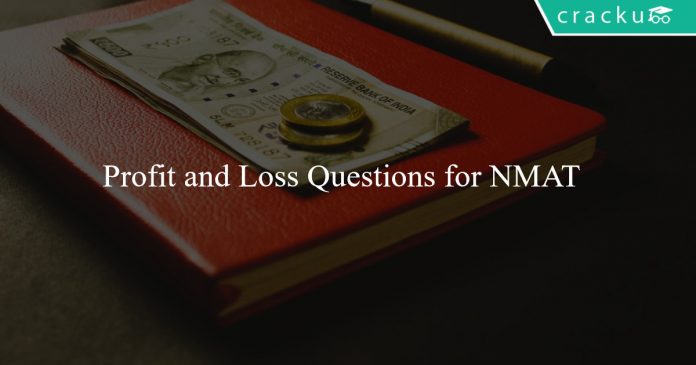Profit and Loss Questions for NMAT:
Download Profit and Loss Questions for NMAT PDF. Top 10 very important Profit and Loss Questions for NMAT based on asked questions in previous exam papers.
Download Profit and Loss Questions for NMAT
Take NMAT mock test
Question 1: Five horses, Red, White, Grey, Black and Spotted participated in a race. As per the rules of the race, the persons betting on the winning horse get four times the bet amount and those betting on the horse that came in second get thrice the bet amount. Moreover, the bet amount is returned to those betting on the horse that came in third, and the rest lose the bet amount. Raju bets Rs. 3000, Rs. 2000 and Rs. 1000 on Red, White and Black horses respectively and ends up with no profit and no loss.Which of the following cannot be true?
a) At least two horses finished before Spotted
b) Red finished last
c) There were three horses between Black and Spotted
d) There were three horses between White and Red
e) Grey came in second
Question 2: Five horses, Red, White, Grey, Black and Spotted participated in a race. As per the rules of the race, the persons betting on the winning horse get four times the bet amount and those betting on the horse that came in second get thrice the bet amount. Moreover, the bet amount is returned to those betting on the horse that came in third, and the rest lose the bet amount. Raju bets Rs. 3000, Rs. 2000 and Rs. 1000 on Red, White and Black horses respectively and ends up with no profit and no loss.
Suppose, in addition, it is known that Grey came in fourth. Then which of the following cannot be true?
a) Spotted came in first
b) Red finished last
c) White came in second
d) Black came in second
e) There was one horse between Black and White
Question 3: Rani bought more apples than oranges. She sells apples at Rs. 23 apiece and makes 15% profit. She sells oranges at Rs. 10 apiece and marks 25% profit. If she gets Rs. 653 after selling all the apples and oranges, find her profit percentage.
a) 16.8%
b) 17.4%
c) 17.9%
d) 18.5%
e) 19.1%
Question 4: The Maximum Retail Price (MRP) of a product is 55% above its manufacturing cost. The product is sold through a retailer, who earns 23% profit on his purchase price. What is the profit percentage (expressed in nearest integer) for the manufacturer who sells his product to the retailer? The retailer gives 10% discount on MRP.
a) 31%
b) 22%
c) 15%
d) 13%
e) 11%
Question 5: Ram and Shyam form a partnership (with Shyam as working partner) and start a business by
investing 4000 and 6000 respectively. The conditions of partnership were as follows:
1. In case of profits till 200,00 per annum, profits would be shared in the ratio of the invested capital.
2.Profits from 200,001 till 400,000 Shyam would take 20% out of the profit, before the division of remaining profits, which will then be based on ratio of invested capital.
3.Profits in excess of 400,000, Shyam would take 35% out of the profits beyond 400,000, before the division of remaining profits, which will then be based on ratio of invested capital.
If Shyam’s share in a particular year was 367000, which option indicates the total business
profit (in ) for that year?
a) 520,000
b) 530,000
c) 540,000
d) 550,000
e) None of the above
Question 6: Rohit bought 20 soaps and 12 toothpastes. He marked-up the soaps by 15% on the cost price of each, and the toothpastes by Rs.20 on the cost price each. He sold 75% of the soaps and 8 toothpastes and made a profit of Rs.385. If the cost of a toothpaste is 60% the cost of a soap and he got no return on unsold items, what was his overall profit or loss?
a) Loss of Rs.355
b) Loss of Rs.210
c) Loss of Rs.250
d) None of the above
Question 7: A pharmaceutical company manufactures 6000 strips of prescribed diabetic drugs for Rs. 8,00,000 every month. In July 2014, the company supplied 600 strips of free medicines to the doctors at various hospitals. Of the remaining medicines, it was able to sell 4/5th of the strips at 25 percent discount and the balance at the printed price of Rs. 250. Assuming vendor’s discount at the rate of a uniform 30 percent of the total revenue, the approximate percentage profit / loss of the pharmaceutical company in July 2014 is:
a) 5.5 percent (profit)
b) 4 percent (loss)
c) 5.5 percent (loss)
d) None of the above
Question 8: In a local shop, as part of promotional measures, the shop owner sells three different varieties of soap, one at a loss of 13 percent, another at a profit of 23 percent and the third one at a loss of 26 percent. Assuming that the shop owner sells all three varieties of soap at the same price, the approximate percentage by which total cost price is lower or higher than the total selling price is
a) 10.5 higher
b) 12.5 lower
c) 14.5 lower
d) 8.5 higher
Question 9: A shopkeeper sells two tables, each procured at cost price p, to Amal and Asim at a profit of 20% and at a loss of 20%, respectively. Amal sells his table to Bimal at a profit of 30%, while Asim sells his table to Barun at a loss of 30%. If the amounts paid by Bimal and Barun are x and y, respectively, then (x − y) / p equals
a) 1
b) 1.2
c) 0.50
d) 0.7
Question 10: Mukesh purchased 10 bicycles in 2017, all at the same price. He sold six of these at a profit of 25% and the remaining four at a loss of 25%. If he made a total profit of Rs. 2000, then his purchase price of a bicycle, in Rupees, was
a) 6000
b) 8000
c) 4000
d) 2000
Join 7K MBA Aspirants Telegram Group
Download Highly Rated CAT preparation App
Answers & Solutions:
1) Answer (D)
In total Raju bets 6000Rs and ends up with no profit – no loss. So there are 3 possibilities.
1) White comes 2nd, Black comes 4th and Red comes 5th.
2) Black comes 1st, White comes 3rd and Red comes 4th or 5th.
3) Black comes 2nd, Red comes 3rd and White comes 4th or 5th.
So there can never be 3 horses between white and red according to above to possibilities. Hence option D cannot be true.
2) Answer (C)
There are total 3 cases which satisfies the condition “no profit and no loss.”
Case 1: White comes 2nd.(remaining two horses(red/black) come 4th/5th)
Profit from white horse = Final Amount – Initial Amount = 2000*3 – 2000 = 4000
Loss from Red and Black horse = 3000+1000 = 4000
Net profit = 4000-4000 = 0
Case 2: Black, Red come second, third respectively.(remaining one horse(white) comes 4th/5th)
Profit from Black = 1000*3-1000 = 2000
Profit from Red = 3000 – 3000 = 0
Loss from white = 2000
Net profit = 2000-2000 = 0
Case 3: black, white come first, third respectively.(remaining one horse(red) comes 4th/5th)
Profit from Black = 1000*4-1000 = 3000
Profit from White = 2000 – 2000 = 0
Loss from Red = 3000
Net Profit = 3000-3000=0
And it is mentioned that grey case 4th. ==> case 1 is wrong.(because, in that case red, black should come 4th,5th)
So option C cannot be true.
3) Answer (B)
Let number of apples = $x$ and oranges = $y$
=> $23x + 10y = 653$ $(x > y)$
Since, 653 has last digit 3, which is possible when 23 is multiplies by 1,11,21,31 and so on.
Also, $x > y$ => $x = 21$ and $y = 17$
=> C.P. of 1 apple = $\frac{100}{115} \times 23 = 20$
C.P. of 1 orange = $\frac{100}{125} \times 10 = 8$
=> Total C.P. = $(21 \times 20) + (17 \times 8) = 420 + 136 = 556$
$\therefore$ Profit % = $\frac{653 – 556}{556} \times 100 = 17.4 \%$
4) Answer (D)
Let Manufacturing Cost of the product = $Rs. 100$
=> Maximum Retail Price(MRP) = $100 + \frac{55}{100} \times 100 = Rs. 155$
Retailer gives 10% discount on MRP
=> Retailer’s selling price = $155 – \frac{10}{100} \times 155 = Rs. 139.5$
It is given that the retailer earned 23% profit on his purchase price, say $Rs. x$
=> $\frac{123 x}{100} = 139.5$
=> $x = \frac{13950}{123} = 113.41$
Now, the purchase price of retailer = $x$ = selling price of Manufacturer
$\therefore$ Profit earned by Manufacturer = $113.41 – 100 = 13.41$
$\approx 13 \%$
5) Answer (D)
Ratio of profits earned by Ram : Shyam = 4000 : 6000
= 2 : 3
If profit < 2,00,000
% of profit earned by Shyam = $\frac{3}{5} \times$ 100 = 60%
If 2,00,000 < profit < 4,00,000, he gets 20 % and 60 % of the remaining profit.
% of profit earned by Shyam = 20% + .80 $\times$ 60% = 68%
If profit > 4,00,000
% of profit earned by Shyam = 35 % + .65 $\times$ 60% = 74%
Now, for first 2,00,000 profit earned by Shyam = $\frac{60}{100} \times$ 2,00,000 = Rs. 1,20,000
For second 2,00,000 profit earned by Shyam = $\frac{68}{100} \times$ 2,00,000 = Rs. 1,36,000
Let total profit earned by them = Rs. (4,00,000 + $x$)
=> From $Rs. x$ profit, Shyam received = 3,67,000 – 1,20,000 – 1,36,000 = Rs. 1,11,000
=> $\frac{74}{100} \times x$ = 1,11,000
=> $x$ = 1,11,000 $\times \frac{100}{74}$ = 1,50,000
$\therefore$ Total profit = 4,00,000 + 1,50,000 = Rs. 5,50,000
6) Answer (A)
Let the CP of 1 soap = S
Thus, the CP of 1 toothbrush = 0.6S
Given that, SP of 1 soap = 1.15 S and SP of 1 toothbrush = 0.6S+20
Also, 15*1.15*S + 8*(0.6S+20) – 15S – 8*0.6*S = 385
Thus, solving we get S = 100
Hence, Total CP of 20 soaps and 12 toothbrush = 20*100 + 12*60 = 2720
SP of 15 soaps and 8 toothbrush = 15*1.15*100 + 8*80 = 2365
Thus, the overall loss = 2365 – 2720 = 355 Rs.
Hence, option A is the correct answer.
7) Answer (C)
It is given that a total of 6000 strips are manufactured out of which the company supplied 600 strips of free medicines to the doctors.
Hence, the number of strips which were sold = 6000 – 600 = 5400.
It is given that the company was able to sell 4/5th of the strips at 25 percent discount and the balance at the printed price of Rs. 250.
Total revenue generated by the firm = $(0.75*250)*(\dfrac{4}{5}*5400)+(250)*(\dfrac{1}{5}*5400)$ = Rs. 1080000
Net revenue after vendor’s discount = 0.7*1080000 = Rs. 756000
We can see that the company invested Rs. 800000 for the drug creation.
Hence, percentage loss incurred by the company = $\dfrac{800000-756000}{800000}*100$ = 5.5%
Therefore, option C is the correct answer.
8) Answer (A)
Let SP of each soap be $X$.
Let’s calculate Cost Price (CP) of each soap separately.
$CP_{1} = \frac{100}{100-13}*X = \frac{100X}{87}$
$CP_{2} = \frac{100}{100+23}*X = \frac{100X}{123}$
$CP_{2} = \frac{100}{100-26}*X = \frac{100X}{74}$
Total cost price of 3 soaps= $\frac{100X}{87}+\frac{100X}{123}+\frac{100X}{74}=3.31X$
Total selling price of 3 soaps= $3X$
Cost price is higher than the selling price by =$\frac{3.31X-3X}{3X}*100 \approx10.5$ percent
Therefore, option A is the correct answer.
9) Answer (A)
CP of the table at which the shopkeeper procured each table = p
It is given that shopkeeper sold the tables to Amal and Asim at a profit of 20% and at a loss of 20%, respectively
The selling price of the tables = 1.2p and 0.8p to Amal and Asim respectively.
Amal sells his table to Bimal at a profit of 30%
So, CP of the table by Bimal (x)= 1.2p*1.3 = 1.56p
Asim sells his table to Barun at a loss of 30%
So, CP of the table by Barun (y)= 0.7*0.8p = 0.56p
(x-y)/p = (1.56p-0.56p)/p = p/p=1
10) Answer (C)
Let the cost of each bicycle= 100b
CP of 10 bicycles = 1000b
It is given that he sold six of these at a profit of 25% and the remaining four at a loss of 25%
SP of 10 bicycles = 125b*6+75b*4
=1050b
Profit = 1050b-1000b =50b
50b=2000
CP = 100b = 4000
We hope this Profit and Loss Questions for NMAT pdf for NMAT exam will be highly useful for your Preparation.






